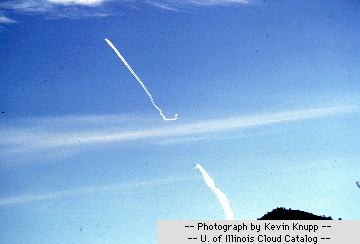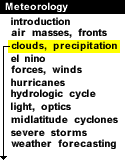
|
A contrail, also known as a condensation trail, is a cirrus-like trail of condensed water vapor often resembling the tail of a kite. Contrails are produced at high altitudes where extremely cold temperatures freeze water droplets in a matter of seconds before they can evaporate.

Photograph by: Knupp
Contrails form through the injection of water vapor into the atmosphere by exhaust fumes from a jet engine. If the surrounding air is cold enough, a state of saturation is attained and ice crystals develop, producing a contrail.

Photograph by: Holle |
If the air in which the contrail develops has a low relative humidity, the cloud particles will quickly evaporate. Even in the presence of higher relative humidities, upper-level winds can spread a contrail apart to produce a horizontal sheet-like cloud. For a contrail to remain in tact for a long period of time, the air must have a high relative humidity in the presence of relatively light winds. |

Vertically Developed |
|

billow clouds |





